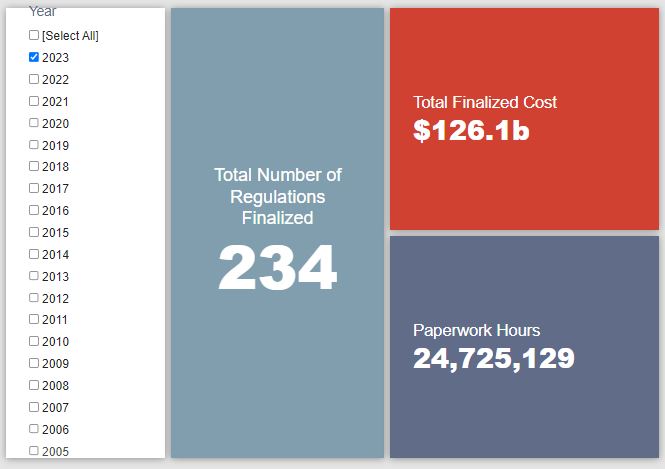Week in Regulation
December 22, 2023
A Late December Surge
While this past week saw only a moderate flow in terms of regulatory volume, there were some heavy hitters in that bunch. There were 11 rulemakings with some quantified economic impact. Multiple rules, however, were well across the billion-dollar threshold. Another set of Department of Energy (DOE) efficiency standards and a Department of Treasury (Treasury) measure further adding to “beneficial ownership” reporting standards were the primary standouts of the week. Across all rulemakings, agencies published $9.2 billion in total costs and added 5 million annual paperwork burden hours.
REGULATORY TOPLINES
- Proposed Rules: 44
- Final Rules: 78
- 2023 Total Pages: 88,679
- 2023 Final Rule Costs: $126.1 billion
- 2023 Proposed Rule Costs: $573.6 billion
NOTABLE REGULATORY ACTIONS
The most significant rulemaking from a cost perspective was the DOE rule regarding “Energy Conservation Program: Energy Conservation Standards for Consumer Furnaces.” Following on the heels of efficiency standards for certain electric motors in the previous week, DOE put forward yet another set of such standards with costs in the billions of dollars. As the rule’s title suggests, this set focuses on “various consumer products and certain commercial and industrial equipment, including consumer furnaces.” The rule specifically addresses “Non-Weatherized Gas Furnaces” and “Mobile Home Gas Furnaces.” The agency estimates that these new standards will result in total “Consumer Incremental Product Costs” of $4.5 billion, or $511 million on an annualized basis.
The other main rule of consequence from last week – particularly in terms of paperwork burdens – was Treasury’s rule on “Beneficial Ownership Information Access and Safeguards.” As the agency notes: “This final rule implements the beneficial ownership information (BOI) access and safeguard provisions in the Corporate Transparency Act (CTA). The rule balances the statutory requirement to create a database of BOI that is highly useful to authorized BOI recipients, with the requirement to safeguard BOI from unauthorized use.” Treasury expects the compliance burdens involved in establishing these safeguards will result in 4.6 million hours of paperwork and $445 million in commensurate costs each year. These compliance burdens come on top of $84 billion in costs from the original rule on BOI reporting. That rule – affecting millions of companies – goes into effect once the Times Square Ball drops next week.
TRACKING THE ADMINISTRATIONS
As we have already seen from executive orders and memos, the Biden Administration will surely provide plenty of contrasts with the Trump Administration on the regulatory front. And while there is a general expectation that the current administration will seek to broadly restore Obama-esque regulatory actions, there will also be areas where it charts its own course. Since the AAF RegRodeo data extend back to 2005, it is possible to provide weekly updates on how the top-level trends of President Biden’s regulatory record track with those of his two most recent predecessors. The following table provides the cumulative totals of final rules containing some quantified economic impact from each administration through this point in their respective terms.![]() With the week’s most notable actions coming in the form of final rules, there was substantial upward movement in the Biden Administration’s to-date totals. Final rule costs and paperwork spiked by nearly $7 billion and 5 million hours, respectively. The rules discussed above were the primary factors in these shifts. For the other two administrations, most of the action came during the Trump Administration. Trump-era costs and paperwork decreased by roughly $860 million and 1.1 million hours, respectively. A deregulatory action from the Environmental Protection Agency provided the bulk of these regulatory cuts.
With the week’s most notable actions coming in the form of final rules, there was substantial upward movement in the Biden Administration’s to-date totals. Final rule costs and paperwork spiked by nearly $7 billion and 5 million hours, respectively. The rules discussed above were the primary factors in these shifts. For the other two administrations, most of the action came during the Trump Administration. Trump-era costs and paperwork decreased by roughly $860 million and 1.1 million hours, respectively. A deregulatory action from the Environmental Protection Agency provided the bulk of these regulatory cuts.
THIS WEEK’S REGULATORY PICTURE
This week, the Department of Transportation (DOT) makes some updates to its national manual on traffic sign and notice parameters. Source: Photo by Josh Connor on Unsplash
Source: Photo by Josh Connor on Unsplash
This past Tuesday, DOT published its rule entitled “National Standards for Traffic Control Devices; the Manual on Uniform Traffic Control Devices for Streets and Highways; Revision.” Specifically, the agency seeks to update the “The Manual on Uniform Traffic Control Devices for Streets and Highways (MUTCD) (also referred to as ‘the Manual’) … to incorporate new provisions that reflect technological advances in traffic control device application.” For further context: “The MUTCD is developed and organized for the purpose of establishing national standards for traffic control devices on any roadway, bikeway, or shared-use path that is open to public travel.” The rule is essentially meant to give some degree of nationwide consistency in sign and device design, even if states and localities have differing transportation planning needs and priorities.
Some of the main updates include:
- Incorporating examples of newer designs such as “pedestrian-actuated rectangular rapid-flashing beacons at uncontrolled marked crosswalks, green-colored pavement for bicycle lanes, red-colored pavement for transit lanes, and a new traffic signal warrant based on crash experience;”
- Prioritizing further measures that focus on pedestrian and bicyclist safety;
- Establishing parameters for emerging technologies such as electric charging stations and automated vehicles; and
- Revising certain aspects of speed limit signage and other devices and signs meant to control the flow of traffic in major thoroughfares.
DOT expects the implementation costs for these changes to be relatively modest at roughly $59.7 million on an annualized basis. According to the agency’s economic analysis, most of the specific device and sign design updates will involve fairly minimal costs. The main cost item will apparently be in relevant state and local agencies updating their training materials and procedures. The rule takes effect January 18, 2024, and DOT expects a five-year compliance window with “up to 2 years to adopt the MUTCD and 3 additional years for agencies to program, fund, and install any devices necessary.”
TOTAL BURDENS
Since January 1, the federal government has published $699.6 billion in total net costs (with $126.1 billion in new costs from finalized rules) and 207.9 million hours of net annual paperwork burden increases (with 24.7 million hours in coming from final rules).










